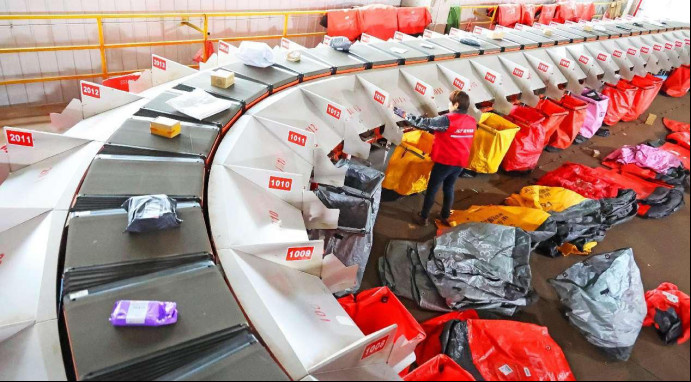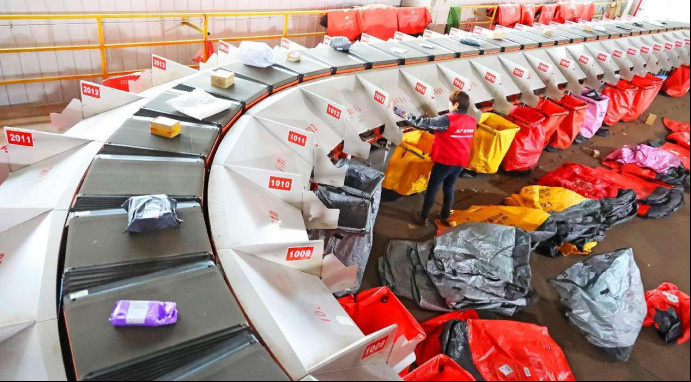By Bai Yifei, People's Daily

Express parcels are sorted and distributed at a public distribution center in Lianyungang, east China's Jiangsu province, Dec. 11, 2023. (Photo by Geng Yuhe/People's Daily Online)
With services including same-day local delivery, cross-provincial next-day delivery, and one-hour pickup, the courier sector is developing faster in China.
This is well indicated by statistics. In the third quarter of this year, the average delivery of express parcels took 54.24 hours in China, 2.5 hours shorter from a year ago; 83.75 percent of express parcels were delivered within 72 hours, with a year-on-year increase of 3.36 percentage points.
The acceleration of courier services has brought a better consumer experience, contributing to the continuous momentum of China's courier sector.
According to monitoring data released by the State Post Bureau, the annual volume of express delivery parcels handled in China surpassed 120 billion for the first time in 2023, reaching a new record high.
High-quality courier services have further invigorated the online retail market. From January to October this year, the online retail sales of physical goods nationwide increased by 8.4 percent year-on-year, accounting for 26.7 percent of the total retail sales of consumer goods. This represents an uptick of 0.3 percentage points from the first nine months, and a year-on-year increase of 0.5 percentage points.
The steady growth of the online retail market has enriched the choices of Chinese consumers and also contributed to the sustained recovery and improvement of consumption.
The development of the online retail market is attributed to the continuous optimization of the market environment and the constant innovation of e-commerce platforms. The former ensures that consumers can make purchases without any worries, while the latter leads to the emergence of new scenarios, forms, and models of business, encouraging the willingness to consume.
For instance, artificial intelligence-generated virtual hosts of livestream commerce can be online all day, selling various types of products under different scenarios. The combination of livestream commerce and cultural tourism also provides consumers with immersive, experiential and interactive consumption experiences. The introduction of new products, services, and innovative approaches has further enhanced consumers' willingness to consume.
According to big data, China's livestream commerce sales exceeded 2.2 trillion yuan ($308.1 billion) from January to October this year, surging 58.9 percent year-on-year and accounting for 18.1 percent of total online retail sales.
The high-quality development of e-commerce has offered new experiences with new scenarios, met new demands with new business forms, and stimulated new vitality with new models. It has continuously fostered new growth points for China's consumption market.
E-commerce networks not only connect cities and rural areas but also link China with the rest of the world. At the recent first China International Supply Chain Expo, the aroma of coffee from different countries filled the exhibition hall, attracting huge numbers of visitors. A wide range of premium imported products have been brought to Chinese consumers through e-commerce platforms, including Spain's ham, Thailand's durian, Zambia's honey, and South Africa's aloe vera gel and wine.
According to statistics, the October sales of Philippine candied fruits, Indonesian hair care products, Chilean wines, and Colombian coffee beans on e-commerce platforms increased by 92.8 percent, 66.9 percent, 40.1 percent, and 25.7 percent, respectively, compared to the same period last year.
Currently, the Chinese consumer market is showing signs of recovery and growth, with increasingly diverse consumer demands. The trend of consumption upgrading remains unchanged.
By closely following the changes in demand, adapting to the upgrading trend, continuously optimizing the supply end, and meeting the needs for quality, diversity, and individuality, China is continuously exploring new market opportunities.
China is making significant progress in promoting new industrialization, informatization, urbanization, and agricultural modernization, with consumption increasingly becoming a fundamental driving force for economic growth.
Currently, the country is striving to enhance its consumption capacity, improve consumption conditions, and innovate consumption scenarios to fully unleash its consumption potential. China has been the world's largest online retail market for consecutive years, with exponential growth in the number of online shoppers over the past decade. The future development of the Chinese online retail market will still be promising.
To create a better environment for the high-quality development of e-commerce, China will fully leverage the unique advantages of e-commerce in connecting online and offline, production and consumption, urban and rural areas, as well as domestic and international markets. It is believed that the country's consumption potential will be effectively unleashed, and the role of consumption in driving economic growth will be further strengthened.
This is well indicated by statistics. In the third quarter of this year, the average delivery of express parcels took 54.24 hours in China, 2.5 hours shorter from a year ago; 83.75 percent of express parcels were delivered within 72 hours, with a year-on-year increase of 3.36 percentage points.
The acceleration of courier services has brought a better consumer experience, contributing to the continuous momentum of China's courier sector.
According to monitoring data released by the State Post Bureau, the annual volume of express delivery parcels handled in China surpassed 120 billion for the first time in 2023, reaching a new record high.
High-quality courier services have further invigorated the online retail market. From January to October this year, the online retail sales of physical goods nationwide increased by 8.4 percent year-on-year, accounting for 26.7 percent of the total retail sales of consumer goods. This represents an uptick of 0.3 percentage points from the first nine months, and a year-on-year increase of 0.5 percentage points.
The steady growth of the online retail market has enriched the choices of Chinese consumers and also contributed to the sustained recovery and improvement of consumption.
The development of the online retail market is attributed to the continuous optimization of the market environment and the constant innovation of e-commerce platforms. The former ensures that consumers can make purchases without any worries, while the latter leads to the emergence of new scenarios, forms, and models of business, encouraging the willingness to consume.
For instance, artificial intelligence-generated virtual hosts of livestream commerce can be online all day, selling various types of products under different scenarios. The combination of livestream commerce and cultural tourism also provides consumers with immersive, experiential and interactive consumption experiences. The introduction of new products, services, and innovative approaches has further enhanced consumers' willingness to consume.
According to big data, China's livestream commerce sales exceeded 2.2 trillion yuan ($308.1 billion) from January to October this year, surging 58.9 percent year-on-year and accounting for 18.1 percent of total online retail sales.
The high-quality development of e-commerce has offered new experiences with new scenarios, met new demands with new business forms, and stimulated new vitality with new models. It has continuously fostered new growth points for China's consumption market.
E-commerce networks not only connect cities and rural areas but also link China with the rest of the world. At the recent first China International Supply Chain Expo, the aroma of coffee from different countries filled the exhibition hall, attracting huge numbers of visitors. A wide range of premium imported products have been brought to Chinese consumers through e-commerce platforms, including Spain's ham, Thailand's durian, Zambia's honey, and South Africa's aloe vera gel and wine.
According to statistics, the October sales of Philippine candied fruits, Indonesian hair care products, Chilean wines, and Colombian coffee beans on e-commerce platforms increased by 92.8 percent, 66.9 percent, 40.1 percent, and 25.7 percent, respectively, compared to the same period last year.
Currently, the Chinese consumer market is showing signs of recovery and growth, with increasingly diverse consumer demands. The trend of consumption upgrading remains unchanged.
By closely following the changes in demand, adapting to the upgrading trend, continuously optimizing the supply end, and meeting the needs for quality, diversity, and individuality, China is continuously exploring new market opportunities.
China is making significant progress in promoting new industrialization, informatization, urbanization, and agricultural modernization, with consumption increasingly becoming a fundamental driving force for economic growth.
Currently, the country is striving to enhance its consumption capacity, improve consumption conditions, and innovate consumption scenarios to fully unleash its consumption potential. China has been the world's largest online retail market for consecutive years, with exponential growth in the number of online shoppers over the past decade. The future development of the Chinese online retail market will still be promising.
To create a better environment for the high-quality development of e-commerce, China will fully leverage the unique advantages of e-commerce in connecting online and offline, production and consumption, urban and rural areas, as well as domestic and international markets. It is believed that the country's consumption potential will be effectively unleashed, and the role of consumption in driving economic growth will be further strengthened.
 Menu
Menu
 China strives to unleash consumption potential
China strives to unleash consumption potential
















